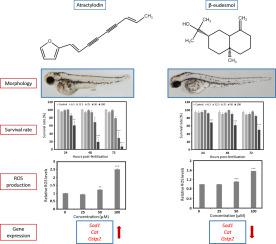Comparative Biochemistry and Physiology C: Toxicology & Pharmacology ( IF 3.9 ) Pub Date : 2020-08-14 , DOI: 10.1016/j.cbpc.2020.108869 Gyem Tshering 1 , Tullayakorn Plengsuriyakarn 2 , Kesara Na-Bangchang 2 , Wittaya Pimtong 3

|
Atractylodin and β-eudesmol are the major active ingredients of Atractylodes lancea (Thunb) DC. (AL). Both compounds exhibit various pharmacological activities, including anticancer activity against cholangiocarcinoma. Despite the widespread use of this plant in traditional medicine in China, Japan, Korea, and Thailand, studies of their toxicological profiles are limited. The present study aimed to evaluate the embryotoxicity of atractylodin and β-eudesmol using the zebrafish model. Zebrafish embryos were exposed to a series of concentrations (6.3, 12.5, 25, 50, and 100 μM) of each compound up to 72 h post-fertilization (hpf). The results showed that atractylodin and β-eudesmol induced mortality of zebrafish embryos with the 50% lethal concentration (LC50) of 36.8 and 53.0 μM, respectively. Both compounds also caused embryonic deformities, including pericardial edema, malformed head, yolk sac edema, and truncated body. Only β-eudesmol decreased the hatching rates, while atractylodin reduced the heart rates of the zebrafish embryos. Additionally, both compounds increased reactive oxygen species (ROS) production and altered the transcriptional expression levels of superoxide dismutase 1 (sod1), catalase (cat), and glutathione S-transferase pi 2 (gstp2) genes. In conclusion, atractylodin and β-eudesmol induce mortality, developmental toxicity, and oxidative stress in zebrafish embryos. These findings may imply similar toxicity of both compounds in humans.



























 京公网安备 11010802027423号
京公网安备 11010802027423号